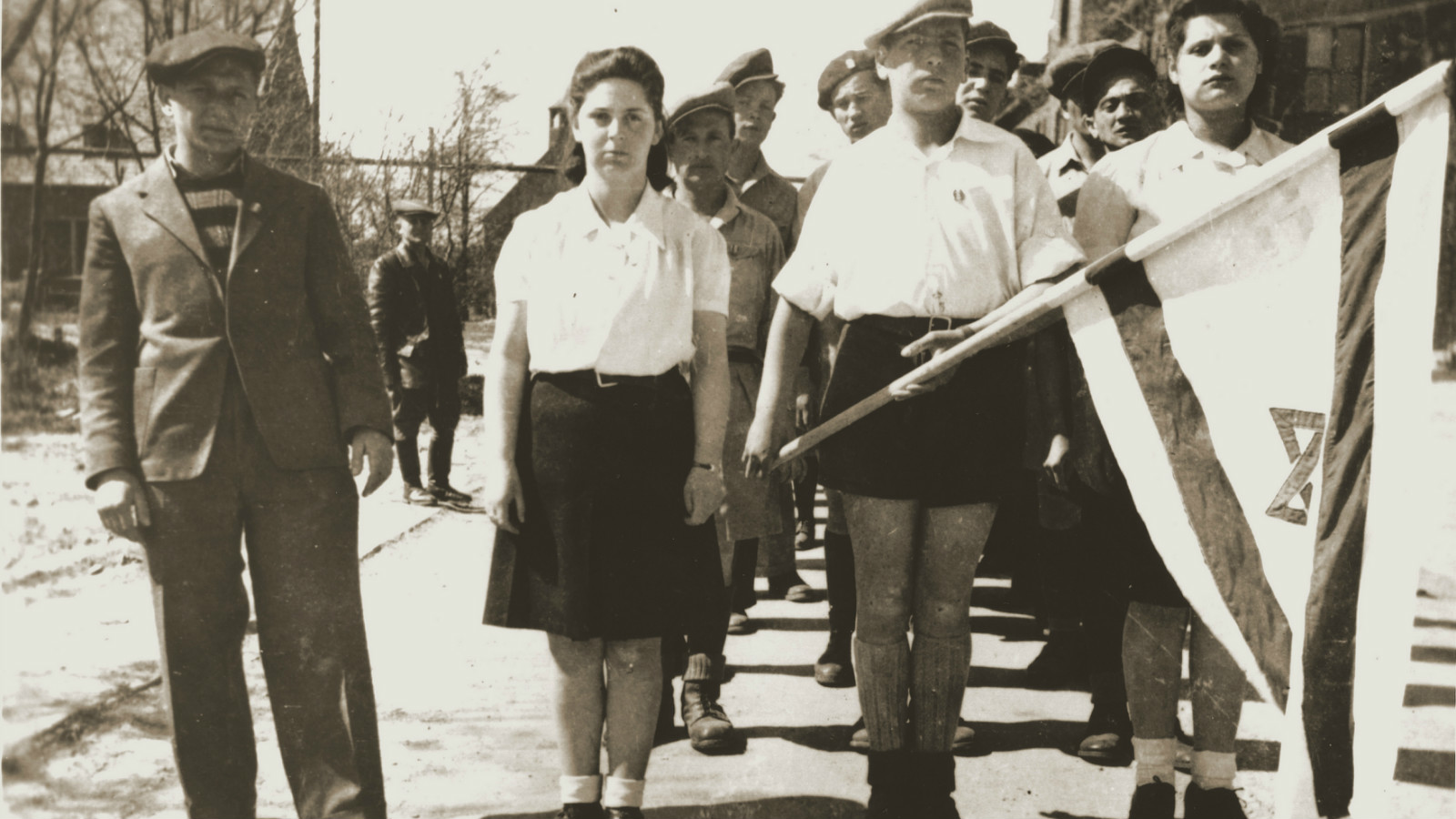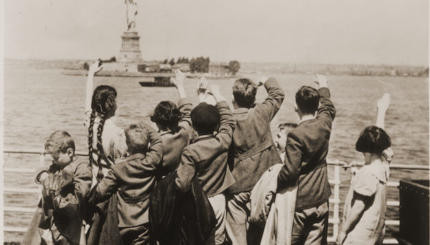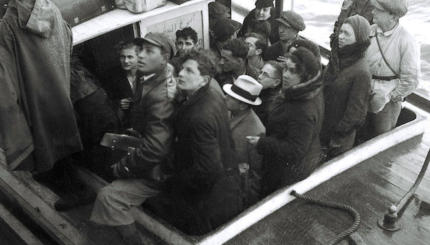At the end of World War II there were about seven to eight million displaced persons (DPs) in Germany and the territories of its former allies. The DPs included former concentration camp inmates, prisoners of war, and East European nationals who had fled from Communist rule to Hitler’s Germany. Most DPs were repatriated soon after the end of the war in May 1945; by July 4.2 million had returned to their home countries, and by September the number had risen to 6 million.
In that period Jews constituted only a small minority of DPs. Approximately 50,000 Jews, mostly from Eastern Europe, who had survived the camps and the death marches, were liberated within German and Austrian territory. Many of them died after liberation as a result of malnutrition, disease, and exhaustion.
The survivors, who referred to themselves as she’erit hapletah (the surviving remnant, a biblical term from Ezra 9:14 and I Chronicles 4:43), wished to leave what they regarded as the cursed soil of Germany as soon as possible. But the doors of Palestine and other destinations remained closed, and in many cases their physical and psychological condition made any immediate move impossible
Just one year after the end of Nazi rule, Germany and the territories of its former allies became the major destinations of Jewish refugees who fled violent anti-Semitism in Poland and other countries of Eastern Europe. The flight of Polish Jewry culminated after the Kielce pogrom of July 1946, when about 700 Jews a day left the country. By the end of 1946 a quarter of a million Jews lived in Germany, Austria, and Italy, with the vast majority in the American occupation zone of Germany, which was considered by the survivors a stepping stone for emigration to Palestine or the United States.
With your help, My Jewish Learning can provide endless opportunities for learning, connection and discovery.
During their stay, between 1946 and 1950, DP camps such as Feldafing, Fohrenwald, Landsberg, and Pocking–located near small towns that had never hosted a Jewish community–for a short time became centers of a vibrant Jewish cultural and religious life.
Political Representation
In many DP camps the liberated Jews elected representatives almost immediately after liberation. In Bergen-Belsen they formed a representative committee as early as 18 April 1945, until the first Congress of Liberated Jews in the British zone convened in September of that year. In the American zone, the Committee of Liberated Jews in Bavaria (later expanded to the Committee of Liberated Jews in the American Zone) was constituted at a meeting on 1 July 1945 in the DP camp of Feldafing. The small community of Jewish DPs in the French zone elected a similar central committee in December 1947.
The two major political leaders elected by the DPs in 1945 were, in the British zone, Josef Rosensaft, a businessman from the Polish town of Bedzin, and, in the American zone, Zalman Grinberg, a physician from the Lithuanian city of Kovno. Most of the pre-war Jewish parties of Eastern Europe participated in the elections, including the socialist Bundists and the Orthodox Agudat Israel.
Unlike in prewar Europe, however, Zionists of all shades now clearly dominated the political spectrum. The official line of all organizations representing the she’erit hapletah was Zionist. They repeatedly called on the British government to open emigration to Palestine, and David Ben-Gurion‘s visit to the DP camps in October 1945 helped to amplify enthusiasm for the Zionist cause.
The Harrison Report
The growing differences between the American and British zones were based on the disparate political interests of the two Western powers. The British, who still controlled Palestine, were anxious to limit the number of Jewish refugees and refused to recognize Jews as a separate nationality, because such a step would have meant a justification for the establishment of a Jewish state.
In the American zone a similar policy was pursued during the first months after liberation. A turning point was reached, however, after the publication in September 1945 of a Report by an investigative committee set up by President Harry Truman and led by Earl G. Harrison, dean of the faculty of law at the University of Pennsylvania.
The Harrison Report stated in the most dramatic terms that “as matters now stand, we appear to be treating the Jews as the Nazis treated them except that we do not exterminate them. They are in concentration camps in large numbers under our military guard instead of SS troops. One is led to wonder whether the German people, seeing this, are not supposing that we are following or at least condoning Nazi policy.”
One of the most important results of the Harrison Report was the recognition of the Jewish DPs as a separate national category, followed by the appointment of an “Adviser of Jewish Affairs.” The United States, however, did not follow Harrison’s urgent advice to receive some of the DPs.
When in June 1948, after long deliberations, Congress finally passed the Displaced Persons Act, it seemed like a mockery to the Jewish survivors. It made only those DPs eligible for admission who had arrived in Germany, Austria, and Italy before 22 December 1945, thereby excluding most of the Eastern European Jewish refugees. In addition, it explicitly preferred ethnic German refugees (Volksdeutsche) over Jewish survivors. Thus, only around 20 percent of the 400,000 DPs who entered the United States between 1945 and 1952 were Jewish.
Similarly, the recommendation of an Anglo-Jewish Commission of Inquiry, which visited the DP camps in February 1946, to open the doors of Palestine immediately to 100,000 Jewish DPs from Germany, was rejected by the British government.
Still in 1945, exclusively Jewish DP camps were created in the American zone, mostly in Bavaria, Wurtremberg, and Northern Hesse, as a response to the Jewish DPs’ refusal to share the same camp with those DPs who had collaborated with the Germans. While some of the Jewish camps were relatively comfortable and located in hospitals or hotels, others differed little in their outward appearance from the barracks of the concentration camps.
Most camps were either former military barracks or emptied apartment complexes. In many respects the life in DP camps was based on the traumatic experiences of the war years spent in German concentration camps. The return to “normal life” was extremely difficult after years of physical deprivation and psychological hardship. The camp administration had to restore a feeling of responsibility for their own lives and a sense of self-respect among a population that had been deeply humiliated.
Cleanliness in the DP camps was a major issue during the first months, as was the possibility to return to interim occupations in or outside the camps. What rendered many of those attempts futile was the continued lack of freedom. “We were liberated, but we are not free,” was a line often found in the statements of Jewish DPs.
Most of the DP camps had barbed wire around them, all had armed guards, and survivors were often forbidden to leave the camp even to search for surviving family members.
Cultural Life
The aftermath of the Holocaust witnessed for a few years a flourishing of Jewish life on German soil unknown in Imperial and Weimar Germany. The survivors created secular and religious forms of culture in Jewish languages —Yiddish and Hebrew — as opposed to German, which had been the language of the prewar German-Jewish culture and religion.
They published close to 100 Jewish newspapers in Europe during the immediate postwar years. Initially, the mostly Yiddish papers had to be printed in Latin characters owing to the lack of Hebrew printing presses. The first Yiddish newspaper, Tehiat Hametim (Resurrection of the Dead), in Buchenwald, appeared even before the war had ended, on 4 May 1945.
The most significant Yiddish newspaper in postwar Germany was Unzer Veg (Our Way), which appeared in Munich between 1945 and 1950 as the official organ of the Central Committee of the Liberated Jews in Bavaria. Among the newspapers produced in the camps, the Landsberger Lager Cajtung in the American zone and Unzer Sztyme in the British zone received the most attention.
Besides news, the newspapers and journals published lists of survivors, recollections of concentration camp experiences, and literary supplements. An especially important historical source, the journal Fun letztn hurban (From the Last Destruction) was published by the Central Historical Commission of the Central Committee of Liberated Jews in the American Zone and contained numerous testimonies of survivors, pictures of the horror in the camps, and songs composed by the inmates.
The larger camps had their own theater troupes, the best known of which was the Munich Jewish Theater (MIT). Often the traumatic experiences of the previous years were reenacted on stage. The MIT troupe performed plays with such telling titles as Kiddush Hashem (Sanctification of the Holy Name, which in Jewish tradition means martyrdom) or Yizkor, the name of the memorial service for the dead.
Schools were established both for the few surviving children and for adults eager to acquire language skills and to prepare for new occupations. Many camps had their own yeshivas, often led by famous rabbinical authorities. Almost each camp had its own sports club, and Jewish soccer teams played each other in several regional leagues.
Most survivors had lost their entire families, and one of the most vivid expressions of their recovered will to live was to found new ones. Weddings were a regular scene in the larger DP camps, and the extremely high birth rate among Jewish survivors stood in blatant contrast to the birth rate among the German population.
Thus in 1945 there were 14 births per 1,000 Jewish DPs in Bavaria, but only five births per 1,000 among the non-Jewish population. The high number of births was also related to the atypical age structure among the survivors, most of whom were in their twenties and thirties.
Emigration
About half the Jewish DPs in Germany, Austria, and Italy–about 120,000 between 1947 and 1950–emigrated to Palestine/Israel. A somewhat smaller number, estimated at 80,000-90,000, went to the United States. This number would have certainly been larger had the Americans opened their doors to emigration more widely. About 20,000 Jewish DPs established homes in Canada, and approximately 5,000 went to Australia and South America, respectively. Many other countries welcomed smaller numbers of Jewish DPs.
In April 1948, one month before the establishment of the State of Israel, there were still 165,000 Jewish DPs in Germany; five months later, their number had dwindled to 30,000. Displaced-persons publications and official statements by Jewish organizations around the world called on the last Jewish DPs to follow suit and leave Germany. Most of them did, but a considerable minority stayed behind, unable or unwilling to leave.
The last DP camp, in Fohrenwald, closed in February 1957, thereby bringing to an end the chapter of displaced persons in post-war Europe.
Reprinted with permission from The Holocaust Encyclopedia (Yale University Press).



